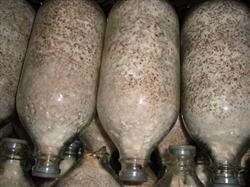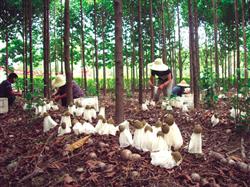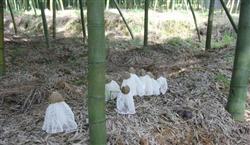Dictyophora planting: what should be paid attention to when planting Dictyophora artificially?

What should be paid attention to when planting Dictyophora artificially? Please give guidance on artificial cultivation of Dictyophora should pay attention to the following points: 1. Field strain production: as long as the grower buys the raw material of Dictyophora, the strain can be cultivated in the field. From late December to early January, select a corner of Tian Tou and sort out a bed for heap breeding. Use 80% sawdust and 20% wheat bran as the culture material of Dictyophora strain, add 110% water, then put it into a woven bag, after sterilization under atmospheric pressure for 10 hours, rinse into the bag with clean water and let it be excreted, then mix in 1% gypsum powder, pile it into the breeding bed, adopt two-layer material, one-layer seed sowing method, and sprinkle some bacteria on the last layer of material, 20 kg of dry material for each meter of 2 border beds. To cultivate an area of 100m 2, only 4m 2 is needed for seed production in the field head, which is equal to 25:1. After sowing, cover the surface with a woven bag, cover the sun with straw, and finally cover the film with a bamboo bow. After sowing, the film was exposed and ventilated every 3 times every 5 days. The hyphae of Dictyophora tenuifolia were cultivated for 50 days after being covered with material pile. 2. Selection of cultivation materials: at present, the raw materials of Dictyophora can be divided into four categories. First, bamboo: culms, branches, leaves, bamboo heads and roots of all kinds of bamboo; second, trees: miscellaneous wood chips, branches, leaves and debris from factory leftovers; third, straw: bean stalk, jute stalk, grain hull, rape stalk, corncob, cotton stalk, cottonseed shell, sorghum stalk, sunflower stalk, shell, etc.; fourth, weeds: Reed, Kan, Osmunda, spot grass, etc., the above raw materials are dried and prepared. 3. Production season arrangement: Dictyophora cultivation is generally divided into spring and autumn. Spring sowing is suitable. There are two points to be grasped for the difference in temperature between north and south of China: one is that the temperature during sowing period is not more than 28 ℃, which is suitable for mycelium growth and development; the other is that the buds develop healthily into fruiting bodies during the 3-month development period of buds after sowing, and the temperature is not lower than 10 ℃. Dictyophora interplanting crops in the southern provinces are usually sown in spring, "stinging" begins to spread and sow, "Qingming Festival" begins to interplant crops, and the north is appropriately postponed. After sowing, the fungus was cultured for 70 days, and the mushroom was produced from May to September in summer, and ended in October. The production cycle was about 7 months. 4. field border bed arrangement: using the space in orchards such as apples, oranges, grapes, peaches and pears, as well as the space of trees in the mountain field to interplant Dictyophora. Requires flat or gentle slopes, close to water sources, and sandy loam containing humus. Clean up the site residue or weeds 10 days before sowing and turn the soil to bleach. Bordeaux liquid can be sprayed on fruit trees to kill diseases and insect pests. In general, the distance between fruit trees is 3 meters × 3 meters, in which the open space is used as a border bed for the cultivation of Dictyophora. The width of the border is 60ml 80cm, and the distance between the sidewalks is 30cm. The soil preparation should not be too broken to facilitate ventilation. Leave 40mur50cm beside the fruit trees as the working path. 5. Sowing and covering soil to raise bacteria: soak the culture material before sowing, and control the water content of 60% / 70%. Sowing takes one layer of material and one layer of seed, and the strain can be sowed on demand or sowed. Put 10 kg of culture material and 5 bottles of bacteria in 2 beds per meter to achieve one side of the auxiliary materials. Sow seeds and then cover the bed with plastic film. Generally, there is no need to spray water after sowing for 20 days. It is best to uncover the film for 30 minutes every day and increase the number of ventilation in the later stage. There are many Rain Water in spring, dig a good drainage ditch, the ditch is 30 centimeters deeper than the border, and the mycelium growth temperature adapts to 23 Mel 26 ℃. After sowing, cover the surface of the border bed with a layer of humus soil 3 cm thick, and the water content of humus soil should be 18%. After covering the soil, cut it into small sections with bamboo leaves or reeds, cover the surface, and cover the border bed with a thin film to prevent Rain Water from leaching. If the way of crop interplanting is adopted, there are tall stalk or vine crops such as soybean, spleen bean, sorghum, corn, pepper, cucumber, sunflower and so on. When Dictyophora is sown and covered with soil for 15 minutes, you can dig holes beside the border to sow crop seeds and interplant one tree at an interval of 50 miles and 60 centimeters. 6. Scientific management of mushroom production: after sowing, the mycelia were cultivated at normal temperature for 33 days, and the hyphae climbed onto the material surface and the film on the bed could be removed. After culture, the hyphae proliferated continuously, absorbed a large amount of nutrients, formed a fungal cord, climbed onto the material surface, transferred from vegetative growth to reproductive growth, and soon appeared mushroom buds and broke the ball to form a fruiting body. At this time, it is a period of luxuriant branches and leaves of forest and fruit trees and interplanting crops, which plays a sunshade role. During the mushroom period, the water content in the culture material should be 60%, the water content of the covered soil should not be less than 20%, and the air relative humidity should be 85%. During the mushroom bud growing period, except for the overcast and rainy weather, water is sprayed once every morning and evening, and the relative humidity is not less than 9%. Mushroom bud bulge gradually appeared at the top bulge, and then break the ball in a short time, pull the handle and spread the skirt as soon as possible to form a fruiting body. Dictyophora cultivation is very particular about spraying water, the specific requirements of "four look": that is, a look at the cover. When bamboo leaves or culms or grass become dry, they should spray water. Second, look at the earth cover. Cover the soil white, to spray more, spray frequently. Look at the buds. Buds are small, light spray, fog spray, buds mostly spray, heavy spray. Four, look at the weather. Spray more evaporation in sunny and dry days, not in cloudy and rainy days. Only in this way can we grow good buds, produce good mushrooms and make flowers beautiful. 7. Harvest, processing and packaging: Dictyophora can grow mushrooms after sowing. The fruiting body matures before 12:00 every morning and should be picked when the fungus skirt is scattered to 4ml 5cm from the bottom of the stalk. After harvest, it is sent to the factory for dehydration and drying in time. Dry products have strong moisture return force, which can be packed in double-layer plastic bags and fastened to the mouth of the bag. As a commodity export and domestic market retail, it is necessary to use small plastic bags, each bag has 25 grams, 50 grams. 100 grams, 300 grams of different specifications, the outer packing using double corrugated Kraft cartons. Click to get more planting techniques of Dictyophora, click to get more planting techniques of edible fungi
- Prev

Dictyophora planting: how can Dictyophora grow high yield?
How can Dictyophora be planted with high yield? Please give guidance to Dictyophora cultivation in order to obtain high yield, it is necessary to know how to grow Dictyophora. The following is to introduce a planting technique for Dictyophora: first, the field requires convenient transportation, loose and fertile soil, high humus content, strong air permeability and not easy board.
- Next

Dictyophora planting: how to grow Dictyophora in the north?
How to grow Dictyophora in the north? Please introduce the method of planting Dictyophora in the north. Please refer to the following techniques: 1. Site arrangement: select cultivated land with sunny, ventilated, fertile soil and convenient drainage and irrigation. Make border bed, width 1m, height 30cm, length variable; border distance 50cm, border surface covered with fertilizer soil above 10cm, leveling. Of course.
Related
- Fuxing push coffee new agricultural production and marketing class: lack of small-scale processing plants
- Jujube rice field leisure farm deep ploughing Yilan for five years to create a space for organic food and play
- Nongyu Farm-A trial of organic papaya for brave women with advanced technology
- Four points for attention in the prevention and control of diseases and insect pests of edible fungi
- How to add nutrient solution to Edible Fungi
- Is there any good way to control edible fungus mites?
- Open Inoculation Technology of Edible Fungi
- Is there any clever way to use fertilizer for edible fungus in winter?
- What agents are used to kill the pathogens of edible fungi in the mushroom shed?
- Rapid drying of Edible Fungi

